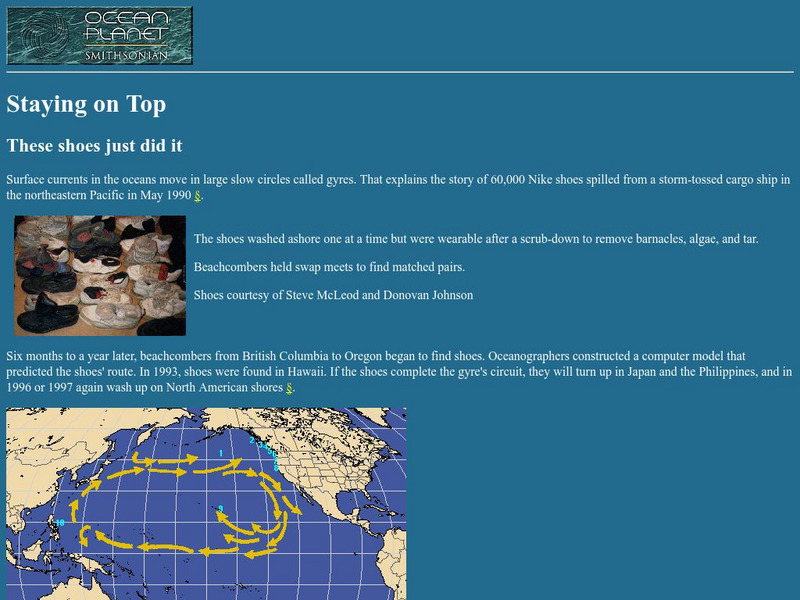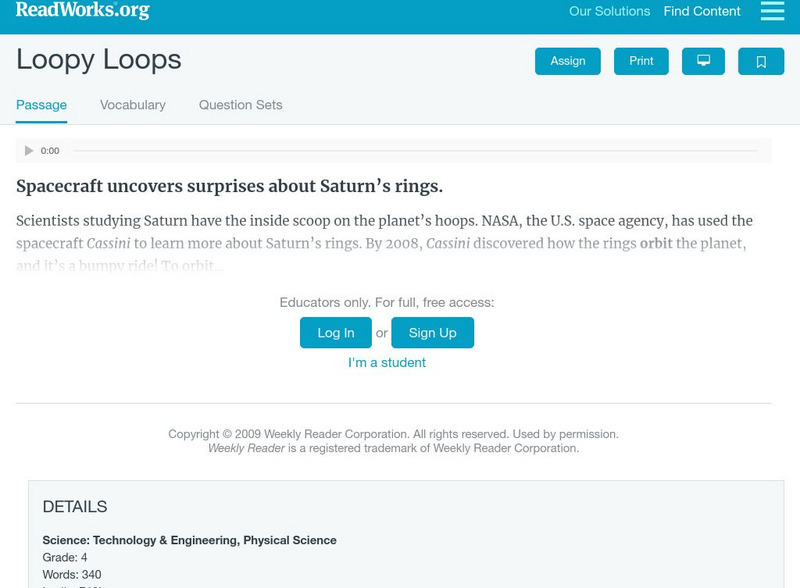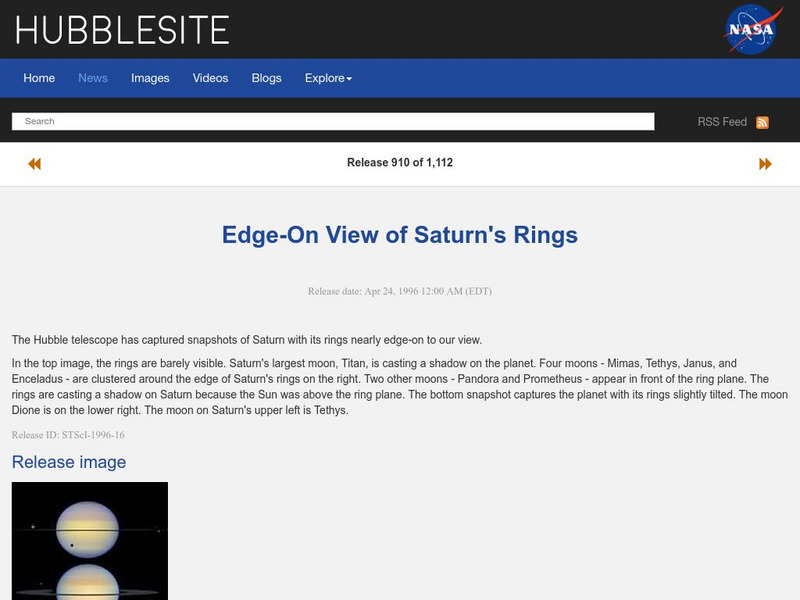NASA
Nasa: Launch a Rocket From a Spinning Planet
This site from the National Aeronautics and Space Administration provides a fun project on rockets. "Nothing in space stands still. Everything either orbits around something else, or moves toward or away from something else. So how do...
Curated OER
Nasa Logo
A portal to resources on the sun, the Earth's neighboring planets, and the weather in space. Find out why Saturn is the "jewel of the Solar System" and explore what happens when Venus and Mercury make their rare transits across the sun.
PBS
Pbs Learning Media: Seasons on Earth and Mars
Compare the seasons on Earth and Mars with NASA imagery. Use this resource to visualize how the axial tilt of a planet influences its seasons and to compare data about seasonal changes on Earth and Mars. Support materials include:...
Smithsonian Institution
Smithsonian Learning Lab: The Universe, an Introduction
Start with the questions all students ask: How big is the universe, how far away are the planets and stars, how did they form and when, how do they move and why? Build on their natural curiosity. The Smithsonian, in cooperation with...
Johns Hopkins University
New Horizons Website
This site from the Solar System Exploration section of NASA provides an overview of the space mission to Pluto, Charon, and the fringes of our Solar System. It describes the Kuiper Belt, and the objects involved with it, provided links...
DOGO Media
Dogo News: Week of 10 21 13: Does It Rain Diamonds on Saturn and Jupiter?
Article reports on research that suggests that rain on Saturn and Jupiter may be made of diamonds. Includes a brief video.
NASA
Nasa: Our Restless Planet
This animation library is a great resource for a diverse list of earth science topics including: tsunamis, land subsidence, magnetic fields, volcanoes earthquakes, floods, and sea level changes.
Smithsonian Institution
National Museum of Natural History: Ocean Planet: Biological Roulette: Alien Species
Click on the roulette wheel and see how some alien species were introduced into the United States and the effect they have had on our country. This is part of an archived Smithsonian exhibit.
Smithsonian Institution
National Museum of Natural History: Ocean Planet: Oil Pollution
Source provides key facts and figures as well as pictures on various oil accidents. Site information is divided up into three categories: Sources, Accidents and Cleanups. This is part of an archived Smithsonian exhibit.
Smithsonian Institution
National Museum of Natural History: Ocean Planet: Staying on Top
This is the story of the infamous Nike shoes that washed off a cargo ship. The shoes later showed up along beaches, giving oceanographers another clue as to how ocean currents move.
Alabama Learning Exchange
Alex: Comets
During this lesson, students have the opportunity to explore comets. By navigating the Internet, viewing a slideshow, and participating in a videoconference with NASA, students will discover what comets are all about.
Curated OER
Nasa: Welcome to the Planets Mercury
NASA offers a photo gallery of Mercury images. Each image includes a detailed caption describing what is being seen, and this caption is also available in streaming audio.
Curated OER
Nasa: Welcome to the Planets Mercury
NASA offers a photo gallery of Mercury images. Each image includes a detailed caption describing what is being seen, and this caption is also available in streaming audio.
Curated OER
Nasa: Welcome to the Planets Mercury
NASA offers a photo gallery of Mercury images. Each image includes a detailed caption describing what is being seen, and this caption is also available in streaming audio.
Curated OER
Nasa: Welcome to the Planets Mercury
NASA offers a photo gallery of Mercury images. Each image includes a detailed caption describing what is being seen, and this caption is also available in streaming audio.
Curated OER
Nasa: Welcome to the Planets Neptune
NASA offers a photo gallery of Neptune images. Each image includes a detailed caption describing what the image is of, and the captions are also available in streaming audio.
Curated OER
Nasa: Welcome to the Planets Neptune
NASA offers a photo gallery of Neptune images. Each image includes a detailed caption describing what the image is of, and the captions are also available in streaming audio.
Curated OER
Nasa: Welcome to the Planets Neptune
NASA offers a photo gallery of Neptune images. Each image includes a detailed caption describing what the image is of, and the captions are also available in streaming audio.
NASA
Nasa: Comet Shoemaker Levy
This site from NASA, Jet Propulsion Lab, provides an extensive look at hundreds of photos and images of space and planets taken from various observatories from around the world. Links are provided throughout as well for additional...
Read Works
Read Works: Loopy Loops
[Free Registration/Login Required] An informational text about Saturn's rings. A question sheet is available to help students build skills in reading comprehension.
NASA
Nasa: Mars Planet Profile
This site has a data table of statistical information about Mars. Among the things listed are density, diameter, distance from the Sun, and much more.
NASA
Nasa: Welcome to the Planets the Voyagers 1 & 2
This web page contains information and images on the pretesting, space simulation, and launch of Voyager I and Voyager II.
ClassFlow
Class Flow: The Metric System
[Free Registration/Login Required] This flipchart is for discussion regarding use of metric system and conversions in chemistry. Includes links to websites for further discussion, to a Power Point Slideshow for teaching conversion, to a...
Space Telescope Science Institute
Hubblesite: Edge on View of Saturn's Rings
This site is from Hubblesite provided by the National Aeronautics and Space Administration. This site provides NASA Hubble Space Telescope snapshots of Saturn with its rings barely visible. A good site to check out on the subject.















